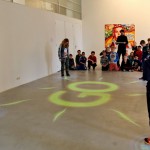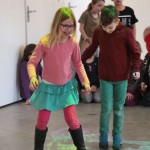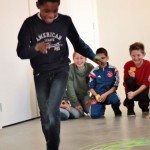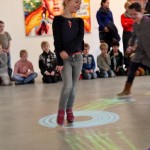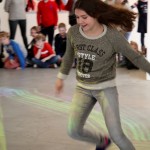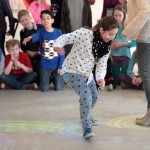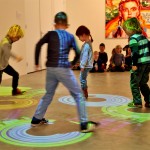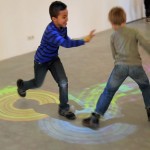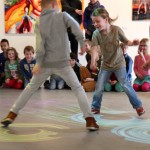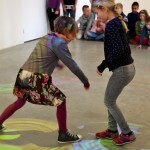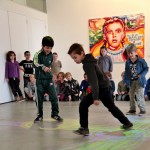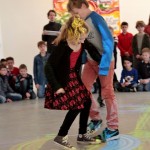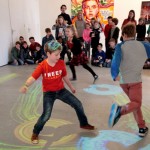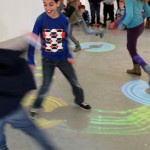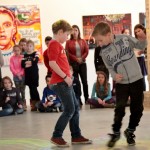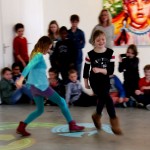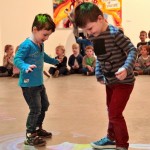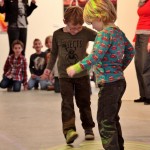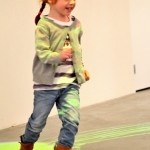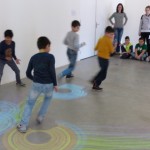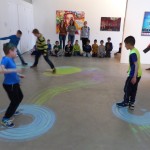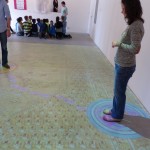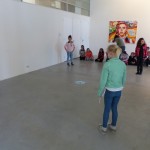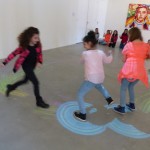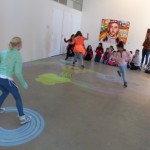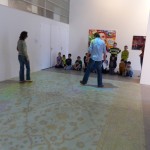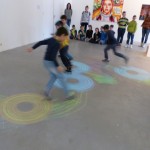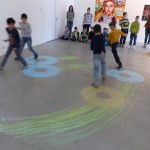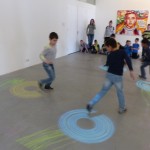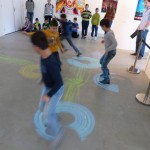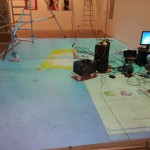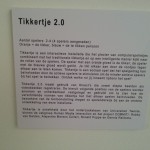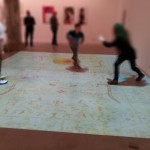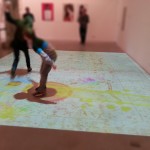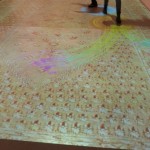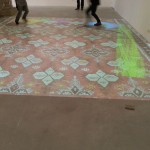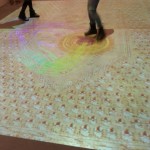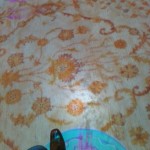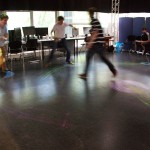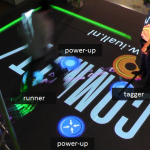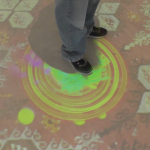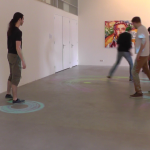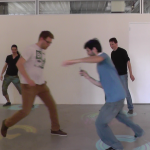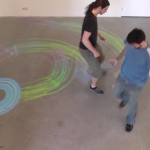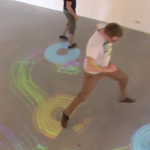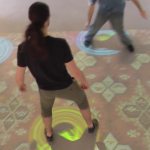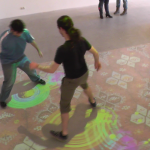Tikkertje 2.0 / Interactive Tag Playground
On this website we present the ITP also known in Dutch as Tikkertje 2.0. We have a Dutch description and both a more general and a more technical description of our research in English below.
Omschrijving van Tikkertje 2.0
Tikkertje 2.0 combineert het plezier van computerspelletjes met het traditionele tikkertje. Het spel maakt gebruik van 4 Kinect sensoren en 2 grote projectoren om een grote interactieve vloerprojectie te maken. Met deze projectie wordt automatisch de rol van de speler met een gekleurde cirkel aangegeven (oranje gloed = tikker, blauwe gloed = renner/te tikken persoon). Om iemand anders te tikken beweeg je jouw cirkel naar die van een andere speler en probeer je de cirkels te laten overlappen. Gedurende verschillende workshops hebben een paar honderd kinderen in Enschede al met heel veel plezier het spel gespeeld.
De posities van de spelers worden anoniem en onherkenbaar vastgelegd en gebruikt om te zien hoe de verschillende vormen van tikkertje het met elkaar spelen beïnvloedt. De spelers van het spel dragen zo anoniem en spelenderwijs bij aan de verdere ontwikkeling van interactieve speelplaatsen.
Tikkertje 2.0 is ontwikkeld door het onderzoeksteam van de Universiteit Twente, vakgroep Human Media Interaction, binnen het COMMIT/ IUALL project en is gratis toegangelijk bij TETEM kunstexpositie tot 27 April 2015.
Photographer Hetty de Vries, children of the Montessorischool Het Zeggelt, Enschede
Description
The Interactive Tag Playground (ITP) is an instrumented open space that allows for interactive play. Several players are tracked and their movements are analyzed and form the basis of several game mechanics. We use a floor-projection to visualize each player’s role, but also add novel interactive elements such as power-ups and bonuses. The ITP is more than entertainment, it doubles as a tool to record and study how people interact with each other and the environment. Our final aim is to automatically steer the interactions in such a way that all players remain engaged and physically active.
Photos by Meriam Odink, teacher at primary school de Regenboog, Enschede. Due to the type of consent, explicit permission is required to use these photos, feel free to contact Robby to discuss possibilities.
Technical details
We use two computers, one for tracking the players and one for running the game. The game is run at a 1920*2400 pixels using two wide angle projectors. The tracking is based on the depth channels of 4 Kinects. Using a smart calibration process the non-active areas are cut away and after detection of the players the four areas are put together to track the players. Using appropriate filters and right set of underlying assumptions, we created a sturdy tracking system.
Using smart networking connections we have diminished lag, can automatically start everything by simply putting the power and projectors on. The network setup also allows us to have multiple computers accessing the tracking information and we are now even working on a distributed version of playing tag (people playing ‘together’ at different locations).
Photos by Robby van Delden, can be used with appropriate credits
Steering gameplay behavior
With the introduction of the technology we can now measure and influence the game. This could allow the playground to detect players that are not really participating or are having a hard time to tag someone. We don’t want to even the game completely. We do like to provide a pleasant experience in which we might prevent teasing and taunting turning into bullying or fights. To show some of these possibilities we did user tests with students at the university. For instance, based on the automatic measurements of the time someone has been the tagger, we changed the size of the circles. Making it easier for the players that had a hard time, by giving them a bigger circle as a tagger, and making it harder for the good players giving them a bigger circle as a runner compared to the other runners. Our results showed that the time students were the tagger indeed evened out more in this version. It also indicated to us that groups in which someone was unable to tag others for a long time (had a small injury) suddenly were better able to play the game with such an intervention.
We also showed that pointing someone out with an arrow increases the chances that this person becomes the tagger, even if it is allowed to tag the other players as well. Therefore, we have created a version with arrows always pointing at the player being the tagger the shortest amount of time.
In another version of the game we added power-ups. We tried to get people to move to different places than they would normally visit, which in turn could increase the amount they walked or support players to get into contact with each other. In our analyses we did see students gathering these power-ups but they wouldn’t stick around for long enough to find any real differences. However, most students preferred such a version and we think that the introduction of these elements might increase the engagement. Therefore, a future concept is to use measurements of total distance walked, that could be indicative for a drop in engagement and then at these moments of lowered engagement let power-ups appear to re-engage the players.
Photos by Robby van Delden, photos of us playing in the playground ourselves, these can be used freely with appropriate credits
Steering behavior through embellishments
During the workshops we did with hundreds of children, we looked whether children were tempted to go towards the tagger if there is a bonus, by steeling small balls from the tagger they can make a circle prettier or win a shield. Will children take this “risk” of getting closer only for the non-functional reward of added “swag”? Or would they only take this “risk” if they got a shield? With such a non-functional intervention to stimulate risk taking, we might also diminish the time someone is a tagger in an adaptive way. Furthermore, we believe this to be a less obtrusive way to do this than directly changing the circle’s size. We could see with direct observations that the children were tempted to take risk by the non-functional reward of embellished circles. We the used the workshops to create several version of the embellishment intervention to improve its effectiveness in order to show a significant effect on the proxemics. We then did a more controlled within subject test, at our lab. These user tests again showed lots of enthusiasm but more importantly showed that this way of steering behavior by embellishments had a significant (but subtle) effect.
This short video shows this study. It also explains more clearly the realization that there seem to be at least three different ways of steering game play behavior in embodied games. The third one is not applied that often (at least not in embodied gaming). One, we often require a certain action, e.g. players need to come close: players have to let their circles touch each other to tag someone. Two, we often insist players to take a certain action with functional rewards, e.g. collect the small balls to get a shield that will protect the player from getting tagged once. Three, besides requiring or insisting, we can also more subtle elicit players actions with non-functional rewards in the form of embellishments. One important advantage, is that it is not forceful it is a subtle way of influencing behavior. Another advantage is that it probably is easier to transfer to other games as they can be add-on on a certain game without requiring change of the previously existing rules. For instance, a different playground could also have collection of small balls leading to prettier circles (or whatever prettier type of player’s representation).
Regulating physical activity
One of the goals of interactive playgrounds can be to stimulate physical activity. Measuring the amount of physical activity can be a tedious task that often requires annotation or the use of sensors that need to be worn. Using the automatic recognized positions of the players we were able to measure the physical activity of the players. We also showed that we could change this amount of physical activity by changing the size of the players’ circles. In the future this can help in regulating the pace of the game in order to efficiently stimulate physical activity.
Type of users
We have had a variety of players, all with a very positive response. Our early experiments included students playing vigorously. During the exposition we had parents with children playing, we had some toddlers walking on the playground, there were some teenagers, and even heard of a grandfather playing with his child. During the workshops there were children from primary schools, mainly in the ages eight to twelve years old. During these workshops part of the group was sitting down as observers. They had an active role making suggestions for the players and supporting players. We did see that the younger children (approx 2-5) were too impressed by the graphics or had a hard time to grasp the game mechanics, for this age group it would be harder to steer during game play.
Two toddlers playing (2 years old) with an older niece. They had seen another group play the game before. However, one might wonder whether they really played the game of tag.
The future?
During numerous splay sessions we have seen many many many interested, very happy and exhausted children. We see a great future ahead for such interactive playgrounds that go beyond kicking some leaves or scaring fishes. We believe it can be used to lower boundaries for playing with others. With the adaptive game-play we could also allow children from different skills play together and might even stimulate them to engage in social interactions through play. In the future we might see such installations, or even this playground in the near future, at family holiday villages, shopping malls or even big furniture shops. A great way to combine the positive aspects of play with the fun of interactive media.
Showcases
Our first demo outside the university was at the COMMIT/ Big Future of Data Event where we brought several leading Dutch computer scientist researchers into contact with the project. It also resulted in numerous positive responses from other visitors, ranging from students to innovation managers, and the ITP did manage to get adults playing tag at such an event.
We also have two semi-permanent set-ups at the university, one is part of the new Design Lab at the University of Twente, the other is located at the SmartXP of the University of Twente. As one of the main showcases of the DesignLab opening we were happy to even have had the honor of our Dutch minister of education interacting with the installation. Besides being there for the opening, experiments and for visitors, the hardware of the setups at the university is also regularly used by bachelor and master students to create several interactive floor games. The ITP software proofed to be a good starting point for quick implementation .
Tetem
Our most elaborative showcase was part of the art exhibition of TETEM kunstruimte. TETEM exhibits both traditional and media arts. The ITP was invited to be one of the main art pieces during the “Zij was eens” exhibition running from the 26th of February until the 26th of April 2015. This was also part of the art-related workshops for children of primary school around Enschede. Several hundreds of children participated in these and played in the ITP. Knowing the total number of visitors is hard but estimates might be reaching up to a thousand. Moreover, we have heard several stories of children coming back especially for playing in the ITP.
News
During an organized school trip to the University of Twente, four primary school classes participated in several play sessions and gave their input for our research processes. Approximately 60 children played with the ITP and again it resulted in very enjoyable play sessions and lots of requests to play again and again.
Involved researchers
Robby van Delden (R.W.vanDelden@utwente.nl)
Alejandro Moreno (a.m.morenocelleri@utwente.nl)
Dennis Reidsma (d.reidsma@utwente.nl)
Ronald Poppe (r.w.poppe@uu.nl)
Dirk Heylen (d.k.j.heylen@utwente.nl)
Publications
- R.W. van Delden, A.M. Moreno Celleri, R.W. Poppe, D. Reidsma and D.K.J. Heylen. Steering Gameplay Behavior in the Interactive Tag Playground. in Proceedings of the European Conference on Ambient Intelligence, AmI 2014, LNCS 8850, pp. 145-157, 2014
- A.M. Moreno Celleri, R.W. van Delden, R.W. Poppe and D. Reidsma Socially Aware Interactive Playgrounds. IEEE Pervasive Computing, 12(3):40-47, 2013
- R. Poppe, R.W. van Delden, A.M. Moreno Celleri and D. Reidsma Interactive Playgrounds for Children. pp. 99-118. In Playful User Interfaces, A. Nijholt (eds), Springer Verlag, Berlin, 2014

